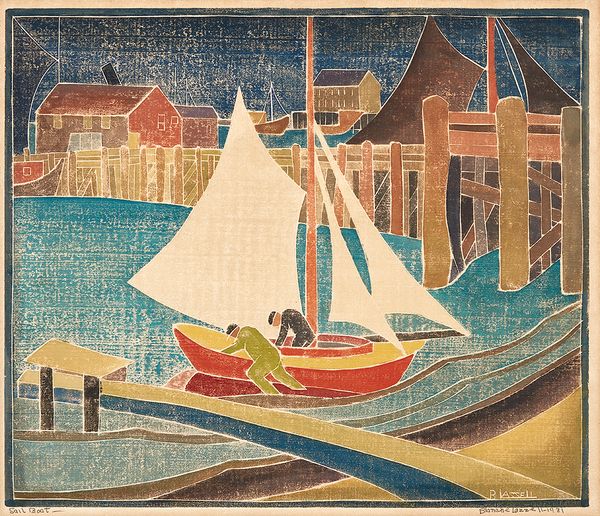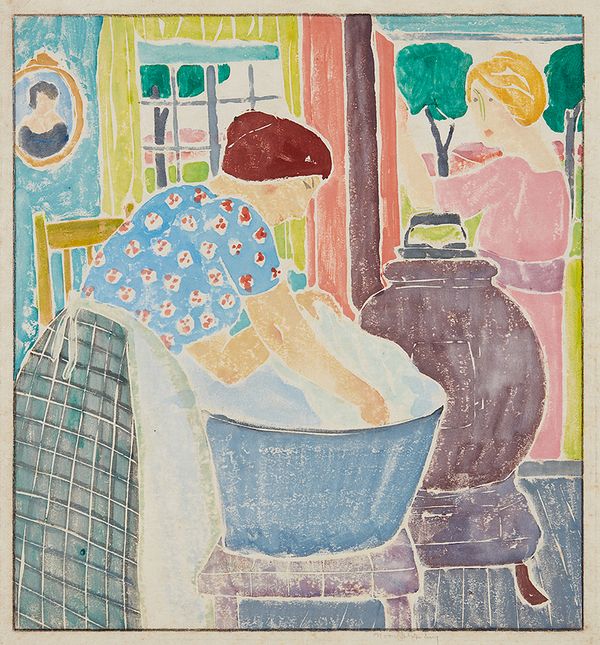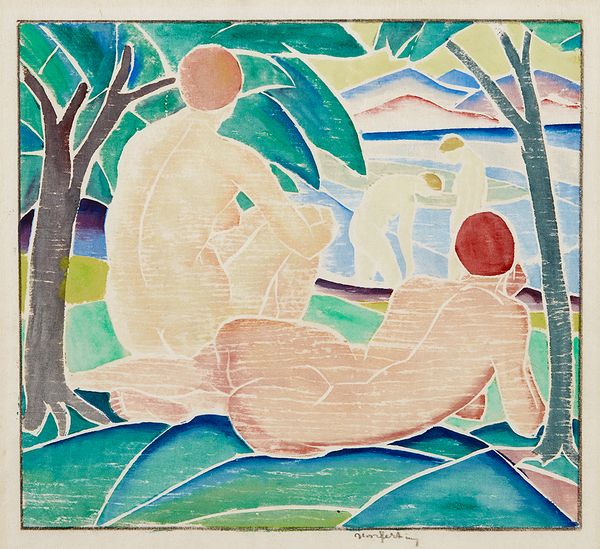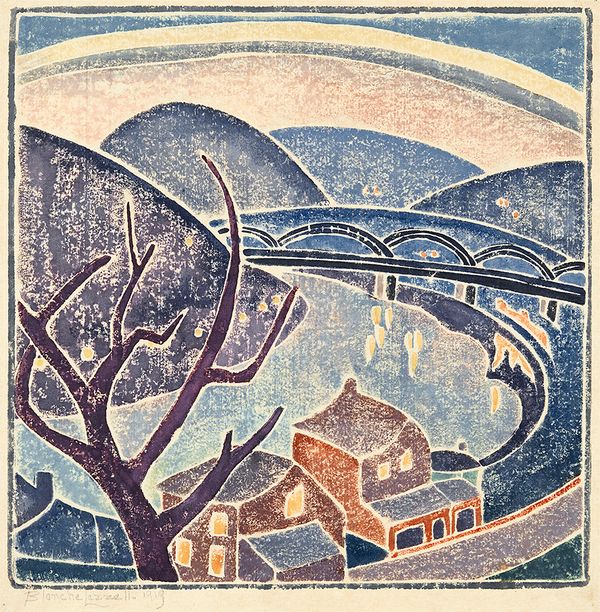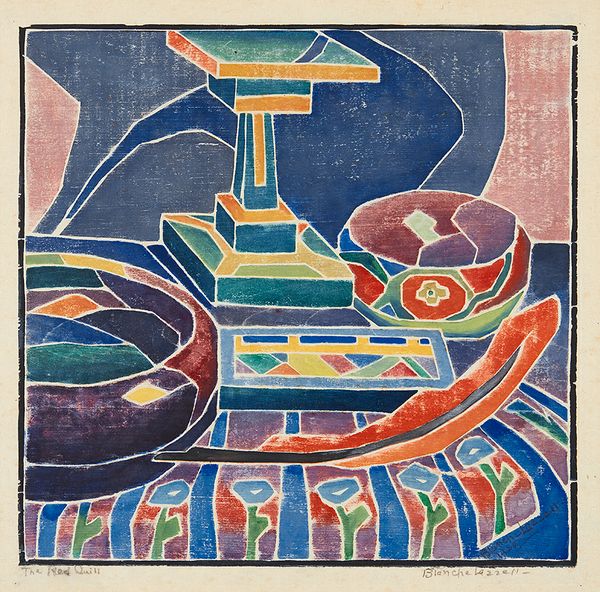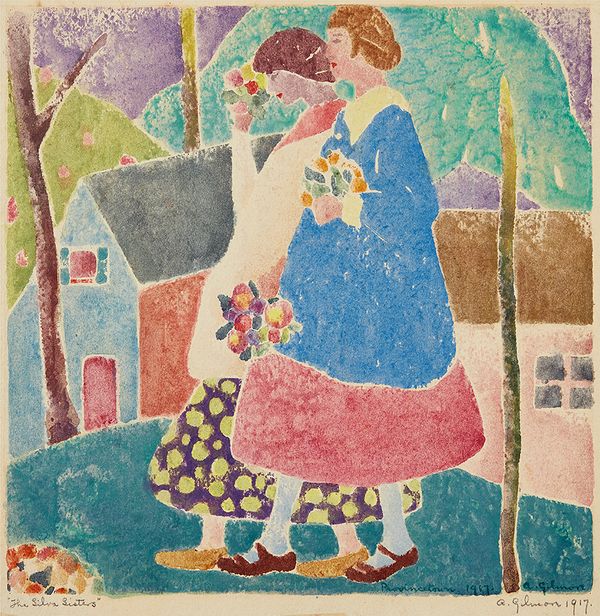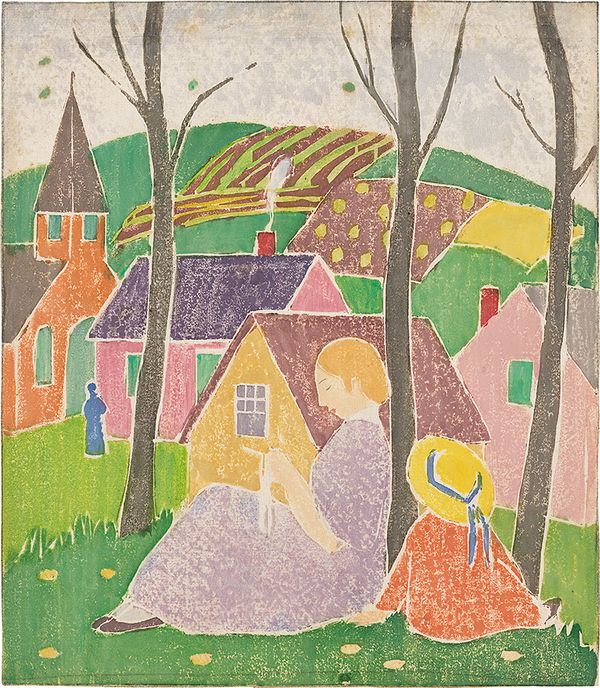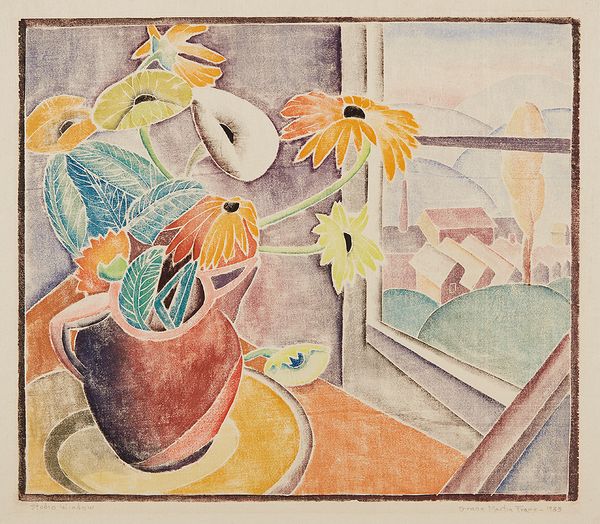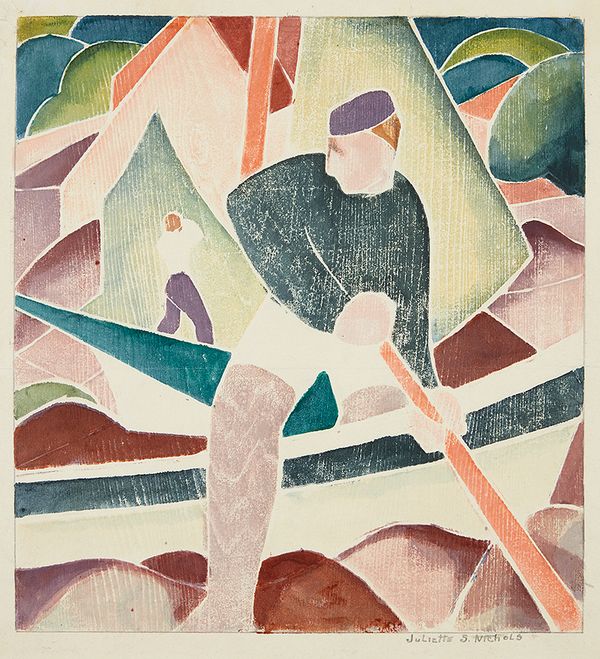Blanche Lazzell, Sail Boat, 1920. Editions & Works on Paper, New York.
Jason Osborne, Associate Specialist on the New York Editions team, takes us back to the iconic coastal town circa 1915, to reflect on a community of remarkably innovative artists.
Visit our 432 Park Avenue gallery this month for the rare opportunity to discover Provincetown Printers, works from a Private Collection, Maryland before they are offered at Phillips’ Editions & Works on Paper auction 24–26 October. On view 17–24 October.
I.
A short list of tools needed to alter the landscape of American printmaking: a thin block of wood, a carving tool, a sheet of paper, a wooden spoon, watercolors, a brush, and an irreverent sense of invention. No presses, heavy limestones, chemicals, or decorated print shop required.
Equipped with these tools, a loose artist collective developed along the quiet shores of Provincetown, Massachusetts, fine tuning and continuously experimenting with a new, perhaps even rebellious, technique of wood block printing that became known as the white-line woodcut.
“Some of the most interesting prints made in America in the first half of the 20th century were the single block color woodcuts that were the specialty of a group of artists based in Provincetown, Massachusetts.”
—Matthew Marks, 1984
This new technique, which required only a single block of wood, reinvigorated not only the woodcut medium itself, but brought classic art historical themes and subject matter into the Modernist conversation. Think bathers, still lifes, the artist’s studio, seascapes, and other marvelously mundane scenes but depicted in a new light. This core cast of artists — Blanche Lazzell, Edna Hopkins, Ethel Mars, Maude Hunt Squire, Ada Gilmore Chaffee, Mildred McMillen, B.J.O. Nordfeldt, and Juliette Nichols (along with others who were “just passing through”) — became collectively known as the Provincetown Printers.
Ada Gilmore Chaffee, Provincetown, 1919. Editions & Works on Paper, New York.
This group of predominantly female artists was responsible for an American renaissance of woodblock printmaking. At the time, woodcuts were more accessible to the artists than lithography, a more time-consuming process that was largely facilitated by male-dominated and increasingly commercialized studios. With adjacence to the arts and crafts movement, these woodcuts offered a more tactile, streamlined, and handcrafted process, liberating artists from the labor-intensive, traditional technique that required a different woodblock to print each color.
A white-line woodcut required only one block, on which artists would carve the image like a drawing. They would then ink the individual segments of the composition with watercolor paints before folding over the image and rubbing the section with a wooden spoon (Yes — a spoon!). The process would often leave tactile embossing where the lines had been carved out — the remaining white lines are the beautifully exposed paper between the inked sections that form the image. While they depicted quotidian scenes, the technique in fact defied almost all the principles of printmaking. Hand-application of non-traditional inks often varied from print to print, accentuating unique elements, and offering an opportunity for experimentation. Further defying tradition, artists often did not ‘cancel’ the block to end the edition but kept them as inherently beautiful art objects and for printing on request. They were at once drawings, woodblock paintings, monoprints, watercolors and — ultimately — completely fresh works of art.
B.J.O. Nordfeldt, Wash Day, 1916. Editions & Works on Paper, New York.
And the most radical gesture of all? The eradication of hierarchy between artist, publisher, and printshop.
“To be in Provincetown for the first time, in those days, under ordinary conditions was delightful enough, but that summer of 1915, when the whole scene, everything and everybody was new, it was glorious indeed.”
—Blanche Lazzell
II.
Provincetown was already known as a summer destination for creatives by 1915. Blanche Lazzell, one of the most accomplished printers from this community, described the village in irresistible terms, recalling that up and down the street “the gayly colored throng constantly moved. The artist with paint box, canvas, and easel, the writers, the musicians … all elbowed one another good-humoredly on the narrow sidewalks of Commercial Street.” In the timeless scene that she describes, an ethos of creative possibility becomes almost familiar. These words could describe a Rabelaisian Carnivale, or the feeling of walking through Bushwick open studios in 2009; perhaps even the atmosphere of the Skowhegan School of Painting and Sculpture in Maine or the Drunk or Stoned shows at the Ranch. Lazzell went on to proclaim of the time, “Creative energy was in the air we breathed. It was in this quaint setting that the Provincetown Print came into being.”
The story of the white-line woodcut begins as the joyous cacophony of Commercial Street was winding down at the end of the summer, when a few of these reacquainted artists decided to hunker down and stay through the winter. During this season, the Swedish-born artist B.J.O. Nordfeldt shared with his friends a new printmaking development that he had been experimenting with: carving the entire image to be printed into the surface of a single woodblock. Once the cat was out of the bag, the group developed the process, and each added their own characteristic nuances.
B.J.O. Nordfeldt, Bathers, circa 1916. Editions & Works on Paper, New York.
Nordfeldt brought to his Bathers (lot 2) a scene that felt distinctly European but would have also been somewhat familiar on the beaches of Provincetown. This print relishes in the potential detail of what can be a clunky medium — the slightly darker underside of the toes, the roots of the trees growing into the earth, the swell of the hills mirroring the curves of the figures’ backs and hips and, most importantly, the modern simplicity of the back of the figures heads that direct our gaze to the bathing figures and the hills of Provincetown.
Blanche Lazzell, The Monongahela, 1919. Editions & Works on Paper, New York.
If Nordfeldt was the credited pioneer, Blanche Lazzell was the master and ambassador of the school. In musical terms, she has no B-sides. It’s easy to see her confidence and mastery in this selection of prints spanning the years 1919–1931. Barn in the Dunes (lot 12) breezes between flatness and depth with ease, at once a Fauvist stained glass window and Matisse papercut. A decade later, Sail Boat (lot 14) exhibits such a specificity of line weight that it ceases to be about white line, the eye instead focusing on the work’s symphonic proportions and balance. One of her most important prints, Monongahela (lot 11), depicts a river from her hometown in West Virginia, but avoids overt nostalgia or sentimentality, depicting the landscape with a remarkable compositional ability and sheer mastery of technique. Quite impressively, Lazzell later moved on from these familiar representational scenes to make what might be the first American non-representational color prints, developing a breadth of work that moved comfortably between representation and abstraction — something that wouldn’t be seen again in America until later in the 20th century through artists like Philip Guston.
Blanche Lazzell, The Red Quill, 1920. Editions & Works on Paper, New York.
By the time these artists arrived on the coast of Massachusetts, they had traveled extensively, soaking up influences from Cubism, Fauvism, the 1913 Armory show, and much else. Their paths would have crossed through various artistic studies and activities stateside, or when mingling in art circles throughout Europe, particularly in Paris. Indeed, although a distinctly American movement, the Provincetown school can be seen to have formed via European Modernist influences. Ada Gilmore Chaffee and Mildred McMillen traveled as a duo in Paris in 1913, where they learned woodcut techniques from Ethel Mars, who in turn had trained with American artist Edna Boies Hopkins, who would later make appearances in Provincetown. Edna had learned the methods of Japanese printmaking from Arthur Wesley Dow and studied it in-depth on a trip to Japan. At this time, the influence of the Japanese woodcut was popular among European artists and printers and deserves the lion’s share of credit for the innovations that followed in Provincetown.
It's easy to imagine the conversations these artists would have had when meeting up again at the end of the Cape:
“B.J.O., I missed the Armory show. How were the Munch woodcuts?”
“Ada, remember those Matisse paintings we saw? There’s so much Matisse on these shores!”
III.
Ada Gilmore Chaffee, The Silva Sisters, 1917. Editions & Works on Paper, New York.
In Ada Gilmore Chaffee’s The Silva Sisters (lot 4), we see a washy bright modern depiction of the local duo, cementing the artist as perhaps the most painterly of the group. There are moments in the foreground, skirts, trees, and borders where the inks bleed into the groove and mingle with the other colors with a looseness as beautiful as any Helen Frankenthaler painting. Ada was one of the original Provincetown printers and, at this time, would have been familiar with these sisters, adding a touch of portraiture to the composition. Her print Provincetown (lot 6) combines landscape and a figure with a dynamic and masterful sense of light that could even make El Greco jealous.
Ethel Mars, Sewing, 1915. Editions & Works on Paper, New York.
A woman of many talents, Ethel Mars was an ambulance driver in France during World War I, taught woodblock printing in Provincetown, crafted rag tapestries, and illustrated a children’s book with Maud Hunt Squire, a fellow Provincetown artist. Sewing (lot 7) contains an illustrative quality that sets up a narrative of daily life and rituals in the town: chores, communing, resting, and enjoying. Utilizing a sophisticated palette, Mars expresses the nuances of different greens to add depth and capture the subtle difference in the hues present in a summer day. Seemingly taking liberties with the houses’ colors, Mars heightens our awareness of the composition and turns each window, leaf, rooftop, and field row into a visual gem.
Grace Martin Taylor, Studio Window, 1932. Editions & Works on Paper, New York.
Along with landscapes, interiors were also a popular subject for white-line woodcuts. Grace Martin Taylor (the younger cousin of Blanche Lazzell!) offers the viewer a look inside her studio in her print, Studio Window (lot 17). In Taylor’s hands, the woodcut scene becomes volumetric with a colorful chiaroscuro. Instead of defining depth with line, she utilizes the hand-coloring process to sculpt the leaves, pitcher, and trees outside. She tempts us with the possibility of an invitation to view the studio only to direct the viewer’s gaze out the window, leaving our attention to oscillate between the Leger-esque landscape and to wonder what artist treasures are being produced outside the boundaries of the picture plane.
Juliette Nichols, Shoving Off, 1921. Editions & Works on Paper, New York.
Alas, we are Shoving Off (lot 3) with Juliette Nichols. One would be hard-pressed (printing pun intended!) to find a print that depicts more dynamic movement and visual strength. The boat operator has trunks for legs and the boat doesn’t flinch under the sailor’s weight. Even the colors submit to the service of the scene — slightly muted tones of dark reds and somewhat translucent heavy blues. This print represents a departure from the saturated scenes of many other Provincetown prints. It is a borderline tumultuous picture that contains the energy we find in the Provincetown Printers’ visual language and undoubtedly captures the fresh innovation that sparked a movement of American printmakers who redefined the woodblock medium. The remarkable innovation of this group of artists can be explored further through the works of other Provincetown Printers in the sale, including white-line woodcuts by Agnes Weinrich, William and Marguerite Zorach, Angèle Myrer, Alice C. Browne, and more.
Discover More from Editions & Works on Paper, New York >
Recommended Reading
Artists to Watch: Editions & Works on Paper >
It’s Halloween at The Factory >
